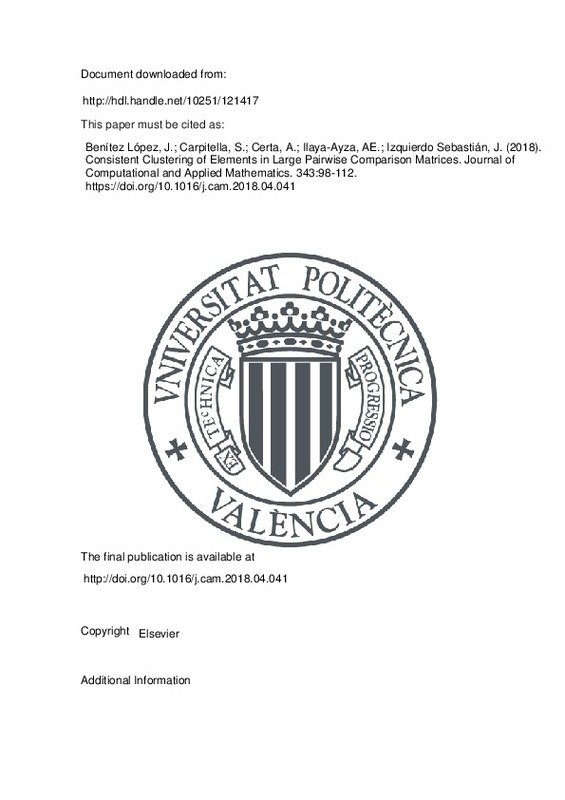JavaScript is disabled for your browser. Some features of this site may not work without it.
Buscar en RiuNet
Listar
Mi cuenta
Estadísticas
Ayuda RiuNet
Admin. UPV
Consistent Clustering of Elements in Large Pairwise Comparison Matrices
Mostrar el registro sencillo del ítem
Ficheros en el ítem
| dc.contributor.author | Benítez López, Julio
|
es_ES |
| dc.contributor.author | Carpitella, Silvia
|
es_ES |
| dc.contributor.author | Certa, A.
|
es_ES |
| dc.contributor.author | Ilaya-Ayza, Amilkar Ernesto
|
es_ES |
| dc.contributor.author | Izquierdo Sebastián, Joaquín
|
es_ES |
| dc.date.accessioned | 2019-06-01T20:01:26Z | |
| dc.date.available | 2019-06-01T20:01:26Z | |
| dc.date.issued | 2018 | es_ES |
| dc.identifier.issn | 0377-0427 | es_ES |
| dc.identifier.uri | http://hdl.handle.net/10251/121417 | |
| dc.description.abstract | [EN] In multi-attribute decision making the number of decision elements under consideration may be huge, especially for complex, real-world problems. Typically these elements are clustered and then the clusters organized hierarchically to reduce the number of elements to be simultaneously handled. These decomposition methodologies are intended to bring the problem within the cognitive ability of decision makers. However, such methodologies have disadvantages, and it may happen that such a priori clustering is not clear, and/or the problem has previously been addressed without any grouping action. This is the situation for the case study we address, in which a panel of experts gives opinions about the operation of 15 previously established district metered areas in a real water distribution system. Large pairwise comparison matrices may also be found when building comparisons of elements using large bodies of information. In this paper, we address a consistent compression of an AHP comparison matrix that collapses the judgments corresponding to a given number of compared elements. As a result, an a posteriori clustering of various elements becomes possible. In our case study, such a clustering offers several added benefits, including the identification of hidden or unknown criteria to cluster the considered elements of the problem. (C) 2018 Elsevier B.V. All rights reserved. | es_ES |
| dc.language | Inglés | es_ES |
| dc.publisher | Elsevier | es_ES |
| dc.relation.ispartof | Journal of Computational and Applied Mathematics | es_ES |
| dc.rights | Reconocimiento - No comercial - Sin obra derivada (by-nc-nd) | es_ES |
| dc.subject | Pairwise comparison | es_ES |
| dc.subject | AHP | es_ES |
| dc.subject | Miller's magic number seven | es_ES |
| dc.subject | Water distribution system (WDS) | es_ES |
| dc.subject | Management and operation of a WDS | es_ES |
| dc.subject | Decision-making | es_ES |
| dc.subject.classification | MATEMATICA APLICADA | es_ES |
| dc.title | Consistent Clustering of Elements in Large Pairwise Comparison Matrices | es_ES |
| dc.type | Artículo | es_ES |
| dc.identifier.doi | 10.1016/j.cam.2018.04.041 | es_ES |
| dc.rights.accessRights | Abierto | es_ES |
| dc.contributor.affiliation | Universitat Politècnica de València. Departamento de Matemática Aplicada - Departament de Matemàtica Aplicada | es_ES |
| dc.description.bibliographicCitation | Benítez López, J.; Carpitella, S.; Certa, A.; Ilaya-Ayza, AE.; Izquierdo Sebastián, J. (2018). Consistent Clustering of Elements in Large Pairwise Comparison Matrices. Journal of Computational and Applied Mathematics. 343:98-112. https://doi.org/10.1016/j.cam.2018.04.041 | es_ES |
| dc.description.accrualMethod | S | es_ES |
| dc.relation.publisherversion | http://doi.org/10.1016/j.cam.2018.04.041 | es_ES |
| dc.description.upvformatpinicio | 98 | es_ES |
| dc.description.upvformatpfin | 112 | es_ES |
| dc.type.version | info:eu-repo/semantics/publishedVersion | es_ES |
| dc.description.volume | 343 | es_ES |
| dc.relation.pasarela | S\361587 | es_ES |







![[Cerrado]](/themes/UPV/images/candado.png)

